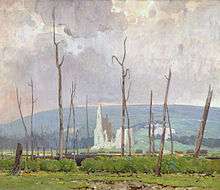John William Beatty
John William Beatty (1869–1941) was a Canadian painter[1] who was a forerunner in the movement which became the Group of Seven in 1920.
Early Painting Life

Beatty hailed from Toronto, Ontario. He turned to painting in 1894 and shortly after, in 1900, studied at Académie Julian in Paris. He travelled throughout Europe from 1906 to 1909 and returned home with many dark, rich, moody paintings of Dutch peasant life.[2]
Paintings of Algonquin Park were becoming a theme of Canadian painters in the early 1900s. In 1909, the year he returned to Canada, he went to the park in order to paint Canadian landscape themes. He painted The Evening Cloud of the Northland in 1910.[3] Beatty felt that this work represented Canada much better than his previous work called "A Dutch Peasant", so he asked the National Gallery if they would exchange the two because, as he explained, "I am a Canadian. I would much rather be represented by a Canadian picture."[4] "The Evening Cloud of the Northland" is considered a masterpiece and is kept at the National Gallery of Canada.
Influences
He shared common interests and feelings with his friends, Lawren Harris, A.Y. Jackson, Tom Thomson, and Arthur Lismer, several of whom later became members of the Group of Seven.
He worked as a war artist for the Canadian Expeditionary Force in 1917.[5]
Honours
See also
Notes
- ↑ Benezit Dictionary of Artists
- ↑ Reid, Dennis R. (1988). A Concise History of Canadian Painting, p. 139.
- ↑ AMICA Library (Art Museum Image Consortium Library), The Evening Cloud of the Northland, 1910.
- ↑ Reid, p. 140.
- ↑ Art Gallery of Ontario, "Canvas of War: Masterpieces from the Canadian War Museum," October 2001-January 2002.
- ↑ "Members since 1880". Royal Canadian Academy of Arts. Retrieved 11 September 2013.
References
- Reid, Dennis R. (1988). A Concise History of Canadian Painting. Toronto: Oxford University Press. ISBN 9780195406641; ISBN 978-0-19-540663-4; OCLC 18378555
External links
| Wikimedia Commons has media related to John William Beatty. |